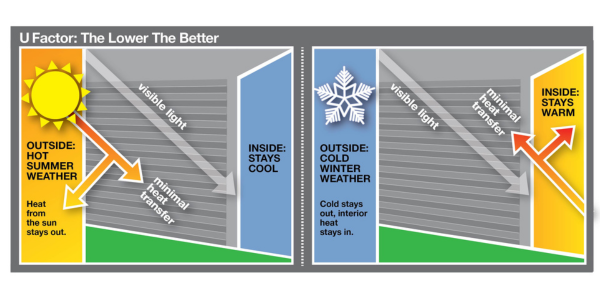

Cookson Blog
Welcome to the Cookson Blog! - Roll Up Door and Security Grille news - What's New?
SUBSCRIBE
Get updates on new blog posts to your inbox!
U-Factor and R-Value Explained Simply
If you're scratching your head over U-Factor and R-Value, you're not alone. These values, which represent the thermal performance of building products, are used in various industries. This includes the commercial garage door industry, where you'll encounter both U-Factor and R-Value, as well as U-Value. To clarify the differences we consulted with Nathan Janiczek, our expert design engineer.
U-Factor and U-Value aren’t actually the same.
In the context of thermal insulation, the terms "U-Value" and "U-Factor" are often used interchangeably, leading people to believe that they represent the same concept.
 “It just so happens that ‘value' is used more in a generalized or scientific context,” explains Janiczek. “It seems that we started using the term in the garage door industry to differentiate the performance of a more complex assembly.”
“It just so happens that ‘value' is used more in a generalized or scientific context,” explains Janiczek. “It seems that we started using the term in the garage door industry to differentiate the performance of a more complex assembly.”
He continues by explaining that U-Value and R-Value are more closely related in that these two equations measure only a part (or a slat) of the door, not the whole assembly.
“Calculating the total U-Factor of an assembly requires some more complex math. If the assembly is a wall consisting of three layers, it’s not too hard: add up the air film on each side and the R-Values of each and take the inverse. But when the components are no longer stacked from the hot side to the cold side, it gets more complex,” he said.
Simply, U-Value and R-Value is a calculation that measures the thermal performance of a slat or a section, while U-Factor is a tested measurement of the full door assembly. A good way to remember this is that U-Factor ‘factors in’ the whole door, while U-Value and R-Value is a calculation of a singular value for a component of a door.
U-Factor is better than R-Value when measuring the thermal performance of a rolling door.
When comparing the heat transfer of garage doors, you'll often encounter the R-Value. However, this number only reflects the performance of the door's most insulative component, typically a slat. It also only measures the performance through the best part of the slat and ignores other geometry that may worsen the performance.
While the R-Value may appear impressive, it's important to note that it doesn't account for the entire door assembly. In contrast, to obtain the U-factor, which measures the overall insulation effectiveness, the entire installed door assembly, including all its components such as the assembled curtain, frame, bottom bar, and perimeter seals undergoes rigorous testing.
“U-Factor and R-Value are often mistaken for each other, but they represent different measurements of heat transfer. They can’t be compared because U-factor evaluates the entire door and R-Value only evaluates a component. Understanding the differences between the two values can help you make smarter decisions about insulation and energy efficiency,” said Janizeck.
Breaking it down.
- U-Factor measures and “factors in” the rate of heat transfer through the door’s entire assembly. R-Value measures how well a slat or component resists heat transfer.
- U-factor is tested. R-Value is a calculation.
- Typical ranges for U-Factor ratings for insulated commercial doors will fall between 0.8-1.1. R-values will range from 4-12, with most falling around 8.0.
- For U-Factor, you’ll look for a lower rating.

Our Thermiser Max® - Low U Door sets the standard for energy efficiency and climate control with the lowest U-factor rating among steel rolling doors - at just 0.532! Contact our team or find a dealer to learn more.
Contact Us Find a Dealer





